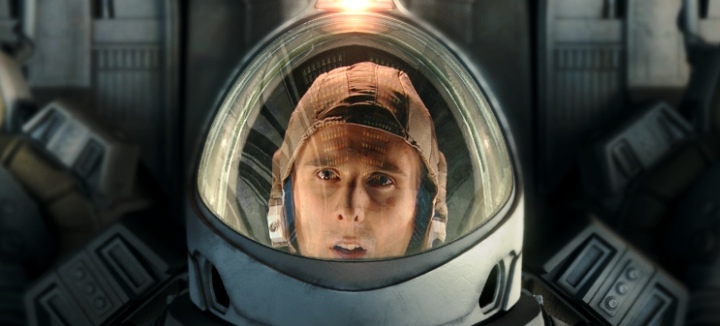
Founded in 2003, Ark VFX applied its skills to the challenge of combining 3D animation with live motion for Muse promo Sing for Absolution. Ark VFX, through production company Colonel Blimp, were asked by East West Records to write a treatment for the promo. Initially devising a story loosely based on the Greek myth of Sisyphus , the idea was further developed with East West and Muse to feature the band starring as pioneering adventures sent on a mission from their dying home planet to transport an ark of frozen souls on a perilous journey to find a new world.
With the final treatment approved, Ark VFX set about locking down a schedule that would allow them to deliver the project in the eight-week time span they’d been given. First they produced a number of test shots to tackle the major technical issue they faced: how to incorporate the band’s live action heads into the CG backgrounds in a believable, convincing way? It was quickly decided that it would be necessary to work with a locked off camera for all scenes featuring the band, as the pre-planning required for elaborate motion tracking shots wasn’t achievable in the few days they had before the band was available for the live shoot. Three basic shots (straight on front, straight side/profile and an angled 45 shot) were decided on for each band member in the cockpit scenes. Also, despite the success of using a Blue Peter-style helmet lighting rig, made from cardboard and fairy lights, during test shots, it was decided that a special lighting rig would have to be constructed that would mimic the internal helmet lighting illuminating the band’s faces. Replicating some of the key environmental lighting conditions, such as traveling down a space wormhole or the re-entry of the stricken spacecraft were crucial to producing the ‘really there’ effect of the promo. Although initially considering a traditional blue/green screen chroma key shoot, after discussions with the DP it was decided that a luma key from a black background would do the job and eliminate any concerns about unwanted reflected light spilling onto the band’s faces.
The band was shot separately, seated in a dentist’s chair to help restrict below the neck movement on Digi- Beta, with a set of detailed storyboards used for reference. With the live footage in the can an intensive week of creating animatics and producing the entire concept art and design for the production (spacesuits, helmets, spacecraft, color design, etc.) began. The animatics were quickly rendered and cut into a rough working edit. These proved to be an indispensable part of the process and much of the animation created for them was used in the final promo. The live action band footage was telecined at Glassworks, with Ark VFX receiving over 250GB of frames back to work with.
Week two saw the beginning of modeling (the spaceship and spacesuits), with a couple of freelances drafted in to ease the heavy workload. Other elements, such as the helmets, cockpit and launch-site were completed in-house. To remain on course with the tight schedule, the less labor-intensive technique of using matte paintings for complex background shots was employed, saving a massive amount of time. A similar shortcut was used for the cockpit shots. By rendering a high resolution still of the cockpit and compositing the shots of the band on top, the need for rendering thousands of frames was cut down. As a consequence, by mid-production the first Muse shots were completed, with their heads seamlessly composited within the computer-generated helmets, suits and backgrounds. Also, a number of the matte painting shots were starting to come together, while the overall tone and feel of the finished product was taking shape, as animatic shots in the edit were being replaced by final or almost final shots on a daily basis.
The thorough planning of the early stages of the project began to pay off, with an absence of the caffeine-induced all-nighters and even a few weekends off. This leisurely pace meant that Ark VFX could revisit and/or re-render some sequences they felt weren’t quite up to scratch. Finally, falling snow and sound effects were added, enhancing the cinematic feel of the video. With all shots completed, the frames were digitally graded and transferred to Digi-Beta at The Mill.
Sign for Absolution was completed using standard PCs running a mix of Lightwave 3D, Adobe Photoshop CS, Premiere Pro, Audition and Digital Fusion DFX for all aspects of the production.
– Originally published in Showreel, Issue 5 (Autumn 2004)

